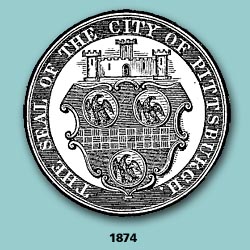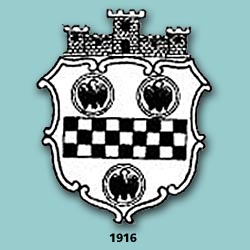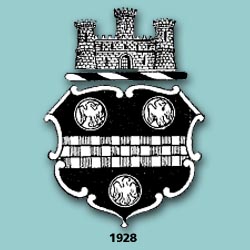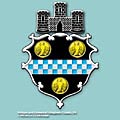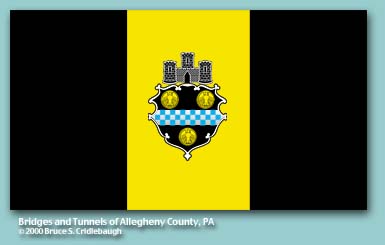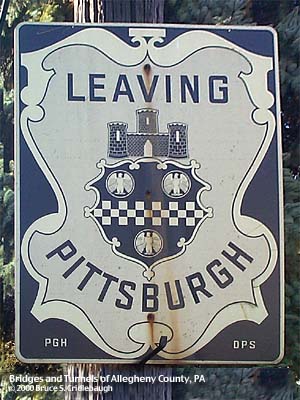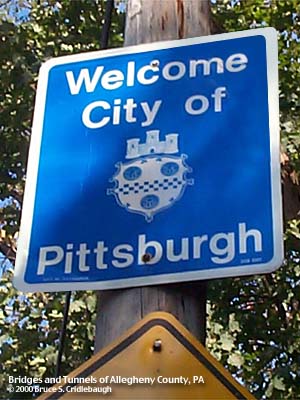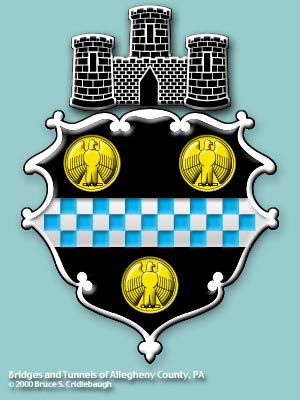| Home > Articles > The Seal of the City of Pittsburgh | ||||
|
|
The Coat of Arms of the City of Pittsburgh click to enlarge samples
The Ordinance from files of Pittsburgh City Council, December 1925 File of Council, City of Pittsburgh, Series 1925, File No. 1877, Bill No. 4361, Presented by Mr. Garland, December 14, 1925, In Committee on Finance, December 15, 1925, Affirmatively Recommended An Ordinance - - Confirming and establishing the Arms of the City of Pittsburgh and providing permanent descriptive and graphic records therof. Whereas, A certain device, adapted from the family arms of William Pitt, First Lord Chatham, has long been and is now employed as the Official Arms of the City of Pittsburgh and as the distinctive feature of its Great Seal; and, Whereas, No ordinance or minute of Council establishing and describing the said device is extant, all records pertaining thereto having been destroyed with other of the municipal archives in the great fire of 1845; and, Whereas, The design of the said City Arms, as of custom employed, should be firmed, and the permanence and integrity thereof insured by proper record and description established in law;
Section 1. Be it ordained and enacted by the City of Pittsburgh, in Council assembled, and it is hereby ordained and enacted by the authority of the same, That The Arms of the City of Pittsburgh have been, and are, properly rendered as follows, to-wit: Section 2. That an accurate colored rendering of the device, done in permanent pigments upon parchment, together with a line drawing of the same in fast black ink upon stout white paper be prepared by a competent person under the direction of the municipal Art Commission, and that these drawings be placed under glass in a fire-proof container, and preserved in the archives of Council. Section 3. That hereafter all representations of the City Arms used upon official documents, publications, and stationery of the City, or as parts of architectural details or decorations in or on municipal structures, or wherever else employed as an official mark of the City shall conform strictly to the hereinbefore mentioned description and the aforesaid drawings. Section 4. That the sum of One Hundred Dollars, or such portion thereof as shall be necessary, be, and is hereby appropriated from Code Account 42--Contingent Fund of the City of Pittsburgh for the purchase of the aforesaid drawings and the necessary provision for their proper preservation.
Section 5. That any Ordinance or part of Ordinance conflicting with the provisions of this Ordinance, be and the same is hereby repealed, so far as the same affects this Ordinance.
Pittsburgh's Seal and Colors from "Pittsburgh School Bulletin" May 1928 The colors of Pittsburgh are gold and black. The flag or ensign is divided vertically into three equal parts; the first and third are black, the middle pale gold. The gold section contains the city's arms -- a shield surmounted by a castellated wall and with three circles, each of which contains the figure of a bird. It is a variation of the arms of William Pitt, Earl of Chatham. Pitt's town, or Pittsburgh, was incorporated as a borough in 1794 and as a city in 1816. July 5, 1816, common council resolved that the recorder be authorized to provide for a seal for the city. To George Harris, silversmith, engraver and sword-maker at Liberty and Smithfield streets, was entrusted the work of providing the seal. Nothing is said in the record concerning the design. In a letter relative to the seal, written by Judge Charles Shaler and dated "May, 1848," is the following: "Charles Willaims, who was our first recorder, was appointed to designate a suitable design for the seal. In this he was aided by the taste and intelligence of the late Morgan Neville. After much discussion, in which everybody's taste was consulted, the armorial bearings of the Chatham family was made the basis of the device of our city seal, and the crest of the Chatham arms was dispensed with and the castellated wall adopted in its stead, so that the device in the seal, in heraldic language, would read, 'City of Pitt.' " On the Chatham arms are three circles representing besants, or coins of Byzantium or Constantinople and no doubt perpetuating the heroism of some member of the family through the Crusades. On the seal of Pittsburgh these circles enclose birds of some kind, the meaning being unknown. An ordinance approved March 15, 1899, established the official flag and colors for Pittsburgh. On the Chatham arms were black, gold (coins), silver and blue; the selection of black and gold for Pittsburgh is most appropriate.
The terminology of Heraldry: the blazon of the city seal
The metals, colors and furs used in heraldry are tinctures. The basic geometric divisions of the shield are ordinaries. The shape of the shield may also be called an escutcheon. Charges and bearings are objects placed within the escutcheon.
Sable - The tincture Black. In engraving it is represented by perpendicular and horizontal lines crossed. Also Diamond and Saturn. Fess or fesse - One of the ordinaries, a strip or band placed horizontally across the shield, occupying one-third of the field. Chequay - A field divided into small squares, of different tinctures, resembling a chess board. Usually made up of seven squares in the top line, and in depth according to the length of the shield. Commonly small squares of metal and colour alternately. There should be at least twenty squares in the shield, in three rows. Argent - The tincture Silver or White. In engravings it is generally represented by the natural color of the paper. It represents purity, innocence, beauty or gentleness. Also Pearl and the Moon. Azure - The tincture Bright Blue or Sky Blue. Engravers represent azure in heraldry by horizontal lines. Also Sapphire and Jupiter. Bezant - A gold roundlet, representing a coin of that name. It is supposed to have been introduced into English heraldry by the Crusaders, who had received the gold coin while in the East at Byzantium and Constantinople. et - Latin word for "and." Eagle - The king of birds. A symbol of courage and power. Rising - A bird represented as if in the act of taking flight; rising from the ground. Wings Displayed - Said of any bird of prey shown erect, with the wings expanded or spread. Inverted - In a contrary direction; turned the wrong way, as a pair of wings with the points downwards. Or - The metallic tincture gold or the color yellow. Engravers represent or as rows of dots. Also Topaz and the Sun. Crest - Originally the crest was the ornament of the helmet, or headpiece, and also afforded protection against a blow. The word "timbre" includes the crest, helmet, wreath, etc., in short everything which is above the shield. Triple-Towered Castle - The Castle is borne very frequently in the insignia of cities and towns.
Masoned - Applied to a field or charge which is divided with lines resembling a wall or building of stones.
Submit info or inquiry - share some facts or ask a question.
Page created:
|
|||
| copyright: © Bruce S. Cridlebaugh 1999-2008 All Rights Reserved | ||||
